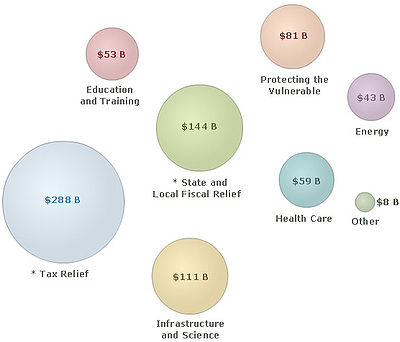New CBO Report Finds Up to 2.9 Million People Owe Their Jobs to the Recovery Act
A new Congressional Budget Office (CBO) report estimates that the American Recovery and Reinvestment Act (ARRA) increased the number of people employed by between 1.0 million and 2.9 million jobs as of June. [1]
In other words, between 1.0 million and 2.9 million people employed in June owed their jobs to the Recovery Act. This estimate, by Congress' non-partisan economic and budget analysts, is more comprehensive than the 550,000 jobs that ARRA recipients reported in July, CBO explains.
While the report focuses primarily on the second quarter of 2011, CBO also includes new projections of the Recovery Act's jobs impact through 2012. It finds that in the current quarter (the third quarter of 2011), there are 0.8 million to 2.5 million more people employed because of ARRA.
The CBO report indicates that ARRA succeeded in its primary goal of protecting the economy during the worst of the recession. As the economy recovers, ARRA's effects will continue to decrease. CBO estimates that ARRA's impact on employment peaked in the third quarter of 2010, when between 1.4 million and 3.6 million people owed their jobs to the Recovery Act.
ARRA Also Boosted Worker Hours, CBO Finds
In addition to saving and creating jobs, ARRA has increased the number of hours worked, CBO has concluded. That is, without ARRA, many full-time workers would have been reduced to part-time status and fewer would have worked overtime. The combination of the increase in jobs and the increase in hours means that ARRA boosted the number of full-time-equivalent jobs by between 1.4 million and 4.0 million as of June, the report estimates. CBO finds that this figure peaked in the third quarter of 2010, and stands at up to 3.4 million full-time equivalent jobs in the current quarter. [2]
Among ARRA's most effective provisions for saving and creating jobs, according to CBO's estimates, are direct purchases of goods and services by the federal government, transfer payments to states (such as extra Medicaid funding), and transfer payments to individuals (such as increased food stamp benefits and additional weeks of unemployment benefits). CBO's estimates indicate that tax cuts are less effective job producers, and tax cuts for higher-income people have very low bang for the buck.
A new Congressional Budget Office (CBO) report estimates that the American Recovery and Reinvestment Act (ARRA) increased the number of people employed by between 1.0 million and 2.9 million jobs as of June. [1]
In other words, between 1.0 million and 2.9 million people employed in June owed their jobs to the Recovery Act. This estimate, by Congress' non-partisan economic and budget analysts, is more comprehensive than the 550,000 jobs that ARRA recipients reported in July, CBO explains.
While the report focuses primarily on the second quarter of 2011, CBO also includes new projections of the Recovery Act's jobs impact through 2012. It finds that in the current quarter (the third quarter of 2011), there are 0.8 million to 2.5 million more people employed because of ARRA.
The CBO report indicates that ARRA succeeded in its primary goal of protecting the economy during the worst of the recession. As the economy recovers, ARRA's effects will continue to decrease. CBO estimates that ARRA's impact on employment peaked in the third quarter of 2010, when between 1.4 million and 3.6 million people owed their jobs to the Recovery Act.
ARRA Also Boosted Worker Hours, CBO Finds
In addition to saving and creating jobs, ARRA has increased the number of hours worked, CBO has concluded. That is, without ARRA, many full-time workers would have been reduced to part-time status and fewer would have worked overtime. The combination of the increase in jobs and the increase in hours means that ARRA boosted the number of full-time-equivalent jobs by between 1.4 million and 4.0 million as of June, the report estimates. CBO finds that this figure peaked in the third quarter of 2010, and stands at up to 3.4 million full-time equivalent jobs in the current quarter. [2]
Among ARRA's most effective provisions for saving and creating jobs, according to CBO's estimates, are direct purchases of goods and services by the federal government, transfer payments to states (such as extra Medicaid funding), and transfer payments to individuals (such as increased food stamp benefits and additional weeks of unemployment benefits). CBO's estimates indicate that tax cuts are less effective job producers, and tax cuts for higher-income people have very low bang for the buck.





